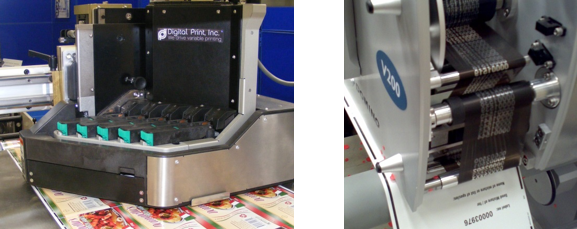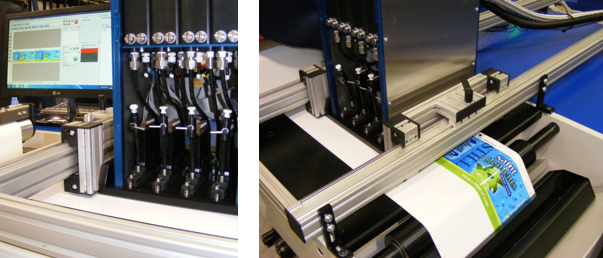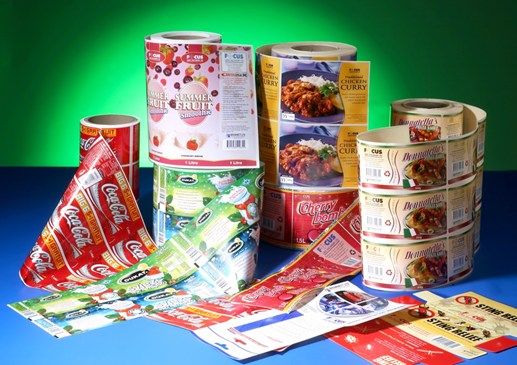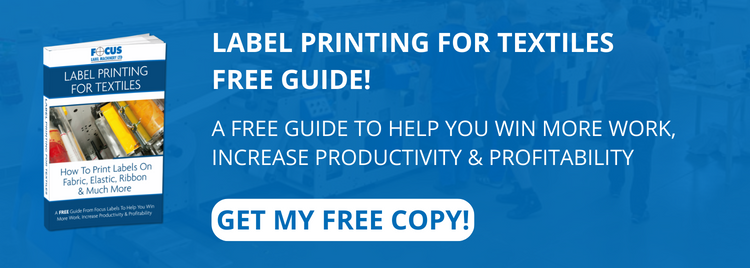
Almost everyone will have some experience of digital printing either at home or in the office through desktop printers, copiers & scanners. Digital technology has made considerable steps forward in the narrow web & labels industry over the past 20 Years. There are now numerous Digital technologies in the market place with investment from under £5K to an eye watering £1.5M GBP. But are they all equal…??
Thermal Transfer:
Digital Liquid Toner:
When Benny Landa launched the Indigo digital press few saw the impact this new company would have on the world of print. After turbulent initial years HP has taken control of the Indigo and arguably has the biggest share of Digital Press installations for the general commercial print business. The system is an offset process where the image is initially printed with liquid toners to a soft rotary blanket which in turn is transferred directly to the substrate. Quality is excellent but materials require a special coating to optimize print quality. Monthly Service & Ink charges can vary according to usage, there is also a click charge per print, much like you would expect with an office copier. Xeikon have recently announced it is launching liquid toner in its range of equipment. In general you expect speeds of around 20 mts/min from basic systems, therefor they tend to be stand alone print engines with separate finishing lines.
Digital Dry Toner:
We are all familiar with toner technology found in mono & colour copiers in the office. In wider web & roll formats ‘Xeikon’ is a leader in this technology where it has championed it micro toner. The system uses heat to fuse/fix the image to the substrate which means there are limitations for sensitive synthetic substrate applications. In general you expect speeds of around 20 mts/min from basic systems. Typical set ups are a stand alone print engine with separate processing for finishing.
Digital Ink jet:
Ink jet a very versatile digital print system finding itself used in virtually all industrial print applications from ceramics & tiling, flooring, direct product decoration, textiles, wood, security printing, packaging & labels. Systems can be multi pass like an XY plotter or single pass units and being compact can be integrated into product, web & roll fed machines.
A drop on demand print head has hundreds of microports, where measured droplets of Ink are fired onto the substrate as it passes under the head. Surfaces can be contoured or flat and the Ink quickly fixed by drying through evaporation or UV curing systems. Ink jet systems can print on a wider range of substrates than other systems, some better quality than others. Print quality is dependent on the surface tension at the point the Ink hits the surface substrate and we would recommend serious testing. In recent years Digital Ink jet has taken over other methods in terms of print resolution (1000 /1800 dpi) & speeds now up to 50 to 120 mts /min for a single pass system. Compact Ink jet engines can also be easily integrated into existing machines.

Digital Memjet:
The first Memjet systems were seen around 2010 and these engines can be found in a number low cost OEM systems. They fit somewhere between office & industrial use. The technology is ink jet & uses a water based dye rather than pigmented inks which is best suited to papers, it is not suitable for synthetic materials unless as they are specially coated. The system promises high resolution. If you have an industrial application we suggest you test for colour fastness in difficult environments. Although the initial system costs can be attractive the ink & consumable print head costs are extremely high in comparison to other high end systems.
Digital Nanography:
First launched in 2012 by ‘Landa’, and system promised delivery for 2013 we are still waiting to see the first beta installations in 2017. By Benny Landa’s own admission they are a little late. The system uses a revolutionary technique of digital printing to a flat offset blanket, the ink turns to a uniform thin film which according to the manufacturers can be transferred to ANY substrate, no special coatings required. ‘Landa’ look like they will focus on the wider format for maximum returns. Equipment, Inks, & servicing costs, click charges have yet to be divulged, but will no doubt follow Mr Landa’s previous business models.… Watch this space…!
In summary these systems are not equal, each offer benefits & disadvantages so do your homework.
Substrates:
The simple fact is that if you select any of the above digital systems they do not print on ALL substrates with equal quality. Some substrates will print perfectly on one digital system but not another.
The number of printable substrates are limited by the technology itself. Some systems will require all substrates to be specially coated which will be more expensive that standard materials. Some of the digital systems can print on a small number of standard substrates straight from the supplier, but other substrates will require coating or pre-treatment (Corona). To optimize quality & keep costs down you may have to encourage your client to use an alternative substrate.







